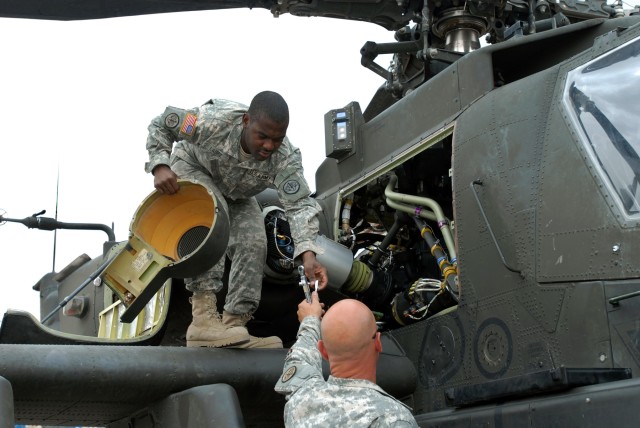
CAMP TAJI, Iraq (April 9, 2008) -- It's a domino effect of sorts. A sudden spike in violence in Basra and Baghdad meant more Soldiers on the ground quickly found themselves involved in kinetic operations. Kinetic operations on the ground meant more AH-64 Apache attack helicopter pilots in the air. For a two-week period, the pilots of Task Force XII found themselves engaging enemy fighters and pushing their aircraft to the limits.
TF XII, the aviation task force supporting Multi-National Division - Baghdad, is led by the 12th Combat Aviation Brigade, a U.S. Army Europe unit headquartered in Ansbach, Germany.
"It's what we all expected coming to Iraq," said 12th CAB executive officer Lt. Col. Charles Bowery, an Apache pilot who, like many other pilots, was pressed into flying more hours to sustain the increase in operations tempo. "I think the greatest strain (with the increased number of aircraft flying) is on the maintenance side of the house."
The aircraft "maintainers," working in the shadows of a highly publicized flurry of activity, say they definitely feel the effects of having aircraft spend more time in battle.
And while the violence in the streets has quelled considerably, the effects of increased flight hours still linger in the aircraft hangars.
"We work two 12-hour shifts," said Pfc. Jemario Laurie, an aircraft maintainer working with Troop T, 4th Squadron, 3rd Armored Cavalry Regiment. "Usually -- either in the morning or at night -- the shifts kind of merge while we get caught up."
Most of the increased maintenance is routine for the aircraft. All helicopters have scheduled maintenance, but as the hours increase, so does the frequency of the schedule.
But like any vehicle, the more you fly a helicopter, the more likely it is that parts will need to be replaced.
"It's a different kind of maintenance," said Staff Sgt. Christopher Gunderson, a Troop T maintenance supervisor. "These guys are used to preventive maintenance. It's changed some to actually fixing stuff."
Gunderson is on his third deployment to Iraq. He says he's used to the aircraft he's worked on seeing more action. He said his challenge has been getting newer Soldiers ready during the relative calm in the months leading up to the recent spike in activity.
"The busier you get, the less time you have to talk to them about the importance of the work they do and the impact of what's happening," he said. "That's when we hope that what we've said before actually sank in."
The dominoes haven't stopped falling yet. For the time being, the tempo remains high as air weapons teams continue to patrol the skies over Baghdad.
Every week the troop commander and first sergeant brief the Soldiers to let the maintainers know exactly where aircraft have been and what they've been doing. A quick glance at a dry-erase board in the hangar lets any member of the ground crews know how many missions their aircraft have flown and how many of the enemy were destroyed as a result.
"I'm very proud to have a part in the impact of these Apaches," said Laurie. "I'm still relatively new to the unit, so knowing that what I do is so important means a lot."

Social Sharing